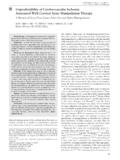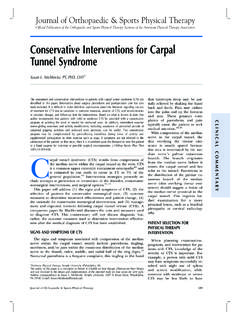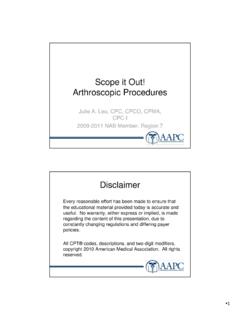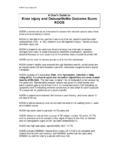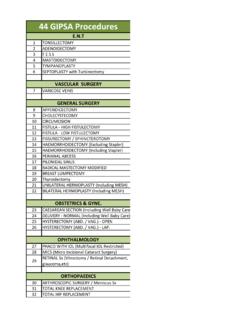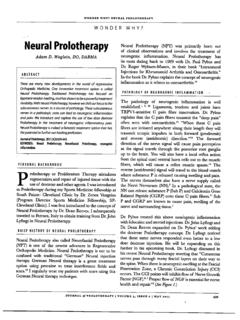Transcription of Physical Therapy Treatment in Patients Who Have …
1 560 | august 2013 | volume 43 | number 8 | journal of orthopaedic & sports Physical Therapy [ research repor t ]Meniscal surgery is among the most common orthopaedic procedures performed today. The American Academy of Orthopaedic Surgeons estimates that about 636 000 knee arthroscopy procedures are performed every year in the United States, and that up to 80% of magnetic resonance imaging scans performed in this country identify the presence of meniscal ,15 Many studies have confirmed the importance of the meniscusto the knee joint, and its loss is associated with instability and degeneration of the are 2 main groups of Patients with meniscus injuries who undergo ar-throscopy: those with acute injuries and those with degenerative injuries. Acute lesions generally occur when an axial load is transmitted directly to the flexed knee associated with In contrast, degenerative lesions are typical of the el-derly and accompanied by degenerative changes in ,36 When injured, the meniscus has little regenerative ca-pacity, mainly due to its vascular system.
2 Middle-aged Patients with degenerative meniscal lesions usually present pain and disability and have impairments in quad-riceps muscle strength and lower extrem-ity the minimally invasive nature, studies have shown that Patients under-going arthroscopic meniscectomy have pain, effusion, loss of range of motion (ROM), functional changes, neuromus-cular and biomechanical changes, loss of quadriceps muscle strength, and a re-duced quality of ,8,12,13,27,30,31,33 Herrlin et al17 showed that for middle-aged Patients with simple lesions in the meniscus, Physical Therapy has yielded TTSTUDY DESIGN: Systematic review with : To evaluate the effectiveness of postoperative Physical Therapy Treatment for Patients who have undergone arthroscopic partial : There is no consensus on which Treatment is best for Patients post : A search for articles published from 1950 to March 2013 was conducted in the MEDLINE, Embase, CINAHL, LILACS, SciELO, IBECS, Scopus, Web of Science, PEDro, Academic Search Premier, and Cochrane Central Register of Controlled Trials databases.
3 The key words were physiotherapy, Physical Therapy modalities, exercise Therapy , rehabilitation, knee, placebo, groups, tibial meniscus, meniscus, arthroscopy, meniscectomy, partial meniscectomy, randomized controlled trial, controlled clinical trial, random-ized, systematic review, and : Eighteen randomized controlled trials were included in the review, 6 of which were included in the meta-analysis. Outpatient Physical Therapy plus a home exercise program, compared to a home program alone, improved function com-pared to a home program alone (mean difference, ; 95% confidence interval: , ; P = .02) and knee flexion range of motion (mean difference, ; 95% confidence interval: , ; P = .0009). Inpatient Physical Therapy alone compared to inpatient plus outpatient Physical Therapy reduced the likelihood of effusion (odds ratio = ; 95% confidence interval: , ; P = .003).TTCONCLUSION: Physical Therapy associated with home exercises seems to be effective in im-proving patient-reported knee function and range of motion in Patients post arthroscopic meniscec-tomy, although the included randomized controlled trials were classified from moderate to high risk of bias and should be interpreted with OF EVIDENCE: Therapy , level 1a.
4 J Orthop Sports Phys Ther 2013;43(8):560-576. Epub 11 June 2013. WORDS: arthroscopy, knee joint, menisci tibial, Physical Therapy , systematic review1 Laboratory of Biomechanics and Clinical Epidemiology, Department of Physical Therapy , Universidade Estadual de Londrina, Londrina, Brazil. 2 Private practice, Ilheus, Brazil. The authors certify that they have no affiliations with or financial involvement in any organization or entity with a direct financial interest in the subject matter or materials discussed in the article. Address correspondence to Dr Jefferson Rosa Cardoso, Laboratory of Biomechanics and Clinical Epidemiology, PAIFT Research Group, Universidade Estadual de Londrina, Av. Robert Rock, 60 CEP 86038-440, Londrina PR, Brazil. E-mail: T Copyright 2013 Journal of Orthopaedic & Sports Physical Therapy JOSILAINNE MARCELINO DIAS, PT, MSc1 BRUNO FLES MAZUQUIN, PT1 FERNANDA QUEIROZ RIBEIRO CERCI MOSTAGI, PT, MSc1 TARC SIO BRAND O LIMA, PT, MSc1 M NICA ANG LICA CARDOSO SILVA, PT1 BRUNA NOGUEIRA RESENDE1 RODRIGO MATSUOKA BORGES DA SILVA, PT2 EDSON LOPES LAVADO, PT, PhD1 JEFFERSON ROSA CARDOSO, PT, PhD1 The Effectiveness of Postoperative Physical Therapy Treatment in Patients Who Have Undergone Arthroscopic Partial Meniscectomy: Systematic Review With Meta-analysis43-08 5607/19/2013 3:47.
5 37 PMjournal of orthopaedic & sports Physical Therapy | volume 43 | number 8 | august 2013 | 561results as favorable as those of arthros-copy, whereas other authors have pointed out that exercise has been shown to be effective in improving the quality of car-tilage after When the Treatment option is surgery, Physical Therapy is typically initiated in the early postoperative phase and progressed as tolerated to restore function to preoper-ative ,45 Although there are many studies on this topic, there is no consen-sus on which interventions and outcomes should be evaluated. This lack of stan-dardization complicates the comparison of studies and thus the determination of which Treatment is best suited for this type of are 2 narrative literature re-views published on this subject: the first was written by Goodyear-Smith and Ar-roll15 in 2001 and the second by Goodwin and Morrissey13 in 2003.
6 Both reviews have notable limitations due to lack of as-sessment of risk of bias, inclusion of non-randomized clinical trials, lack of clarity in explaining the search and retrieval of studies, and lack of quantitative analysis, thus not allowing reproducibility and importance of the matter, the lack of consensus on the Treatment , and the publication of new randomized con-trolled trials (RCTs) justify a systematic review that contains only RCTs, is con-ducted in the Cochrane Collaboration precepts, and can provide a summary of the evidence for use in clinical deci-sion making. Thus, the objective of this study was to evaluate the effectiveness of postoperative Physical Therapy treat-ment on patient-reported knee function, ROM, effusion, and other outcomes of Patients undergoing arthroscopic partial of StudyThis study is a systematic review of RCTs, with A sys-tematic review requires standard-ization; therefore, this study followed the recommendations of the PRISMA state-ment35 and the Cochrane CriteriaStudies were included that evaluated the effectiveness of postoperative Physical Therapy Treatment on Patients with a di-agnosis of meniscal tears who had under-gone arthroscopic partial meniscectomy for either degenerative or traumatic in-juries.
7 Comparisons were made between the different Physical Therapy contexts or their frequency, and Physical Therapy ver-sus the isolated use of specific modalities. According to the recommendations of the Cochrane Collaboration,19 only RCTs were accepted. There were no restrictions as to the age of the of InterventionInterventions in the included studies were a mix of specific interventions such as aerobic, flexibility, and strength-ening exercise; sensory motor training; muscle activation (electromyographic [EMG] biofeedback, electrical stimula-tion); joint mobility exercise; thermo- Therapy ; gait training; and use of plaster or compressive bandage and patient information and educational programs. Interventions are listed in TABLE TypesThe outcomes evaluated were patient-reported function, ROM, effusion, functional tests, quadriceps isokinetic strength, thigh circumference, pain, muscle activity, functional activities, gait, quality of life, muscle histological analyses, time to return to work, and Sources and SearchThe search strategy was formulated by 2 of the authors, assisted by a spe-cialist librarian, in the following da-tabases: MEDLINE (1950-March 2013), Embase (1980-March 2013), CINAHL (1982-March 2013), LI-LACS (1982-March 2013), SciELO (1998-March 2013), Web of Science, PE-Dro, Academic Search Premier, and the Cochrane Central Register of Controlled Trials, IBECS, and Scopus.
8 The search included the following key words: phys-iotherapy, Physical Therapy modalities, TABLE 1 Interventions of Randomized Controlled Trials EvaluatedActive exercise of ankle plantar flexion and dorsiflexionActive exercise of flexion and extension of the kneePatellar mobilizationStretchingIsometric exercise of the quadricepsStrengthening exercises: isokinetic and isotonic Abductors, adductors, flexors, and extensors of the hip Flexors and extensors of the kneeStraight leg raiseElectrical stimulation of the quadricepsElectromyographic biofeedbackNeuromuscular trainingGait trainingStationary bikeCompressive bandageIce((randomized controlled trial [pt]) OR (controlled clinical trial [pt]) OR (randomized [tiab]) OR (placebo [tiab]) OR (groups [tiab])) NOT (animals [mh] NOT (humans [mh])) AND ((meniscectomy [tiab]) OR (arthroscopy [mh]) OR (knee [mh]) OR (tibial meniscus [mh])) AND ((physiotherapy [tiab]) OR ( Physical Therapy modalities [mh]) OR (exercise Therapy [mh]) OR (rehabilitation [sh]))FIGURE 1.
9 Search strategy for the MEDLINE 5617/19/2013 3:47:38 PM562 | august 2013 | volume 43 | number 8 | journal of orthopaedic & sports Physical Therapy [ research repor t ]exercise Therapy , rehabilitation, knee, placebo, groups, tibial meniscus, menis-cus, arthroscopy, meniscectomy, partial meniscectomy, randomized controlled tri-al, controlled clinical trial, randomized, systematic review, and experts were also consult-ed for information about additional trials that might not have appeared in the da-tabases. The search was not restricted to any specific language. The search strategy is demonstrated in FIGURE 1 and the flow chart in FIGURE Selection and Data-Collection ProcessStudies were independently assessed for eligibility by 2 researchers. After conclud-ing the preliminary search findings, each of the studies was examined for relevance to the topic as well as for additional refer-ences of interest that were not revealed in the original comparison categories were created based on the methodologies of the included studies: outpatient Physical Therapy plus home exercise versus home exercise, outpatient Physical Therapy ver-sus home exercise, outpatient Physical Therapy versus control group, outpatient Physical Therapy versus modalities alone, ward Treatment versus ward plus outpa-tient Treatment , routine Physical Therapy versus intensive Physical Therapy , and early versus delayed of Risk of BiasThe studies were evaluated for risk of bias by 2 independent reviewers.
10 When there were disagreements, a third ex-perienced reviewer was consulted to rule on the decision. For evaluation, we adopted items in accordance with the handbook of the Cochrane The risk-of-bias items evaluated were the method of randomization, al-location concealed, patient blinding, care provider blinding, outcome asses-sor blinding, dropout rate, intention-to-treat analysis, reports on the study free of suggestion, change to baseline similarity of participants, cointerven-tions avoided, compliance, timing of the outcome assessment, and These items were evaluated as yes, no, or unclear, according to the recommenda-tions of Furlan et More information is provided in TABLE system described by the Centre for Evidence-based Medicine (Oxford, UK) was used to classify the evidence in this review. The complete table of criteria and details of the grading can be found on the web at An abbreviated version of the grading system30 is as follows: level 1, evidence obtained from high-qual-ity diagnostic studies, RCTs; level 2, evidence obtained from lesser-quality RCTs (eg, improper randomization, no blinding, less than 80% follow-up); level 3, case-controlled studies or ret-rospective studies; level 4, case series; level 5, expert opinion.
